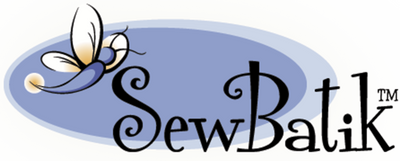
Duvet Cover & Matching Pillow Shams
I have always loved a duvet cover that has style and simplicity. This is the image I had when I decided on this design for our duvet cover and matching pillow shams.
Our 115" wide Batik Cotton is perfect for reducing the amount of cutting and sewing needed to create a duvet cover for a twin, queen, or large king duvet. Our collection of Double Border Phoenix fabric also was perfect... I keep saying perfect, because it really is.
The border fabric is designed with a border running along each selvage edge. The center of the fabric is filled with our Phoenix stamped motif. There is a line that separates the border from the center design.
Duvet Cover Design Elements
As you will see from the image of our Duvet Cover and Pillow Shams I love the border. It had to be the sides and front of the duvet cover. The tricky part of this design is how to "simply" cut and reattach the border to the center of the fabric, all the while creating a mitered corner along the front.
I truly tried not to cut the border away from the center design - but there was no other choice. The mitered corners made it difficult. I kept focused on a simple cutting and piecing design.
 |
The first step in this design was to calculate the number of inches needed for the two sides and front edge of the duvet cover. Remember... The good thing here is that the fabric design includes two borders - one on each selvage edge. This helped reduce the yardage needed for the top of the duvet cover. I did not put the border on the underside of the cover. One word of caution... The border is not perfectly even with the selvage edge of the fabric. This is a hand made item and is not perfect. Make sure you measure from the selvage edge and disregard the white line. If you adjust your cutting space to include a perfect white line you will end up with a curvy border. |
 |
Let's talk a little bit about the top of the duvet cover. The center fabric is all one piece cut from the center of the 115" wide fabric. The border is sewn to each side of the center. The front border of the duvet is also sewn to the lower edge of the duvet cover. Each border extends past the edges of the center piece in order to allow enough fabric to create our mitered corners. |
 |
The mitered corners are simple to mark and sew. Look at the white line in the border ( in the image of the duvet cover ). This is the only line I paid close attention to when sewing the mitered corner. I wanted the line to match. If this line matches, the rest of the border will match perfectly. I do have a word of caution. Batiks are hand made. The borders are a stamp that is hand applied. It is not even and it is not perfect. Just remember this when you are measuring, cutting, and sewing. |
 |
The sewn mitered corner looks wonderful when it is finished! |
The Back of the Duvet Cover
The back of the duvet cover is taken from the center of the 115" wide batik design. The border design is not on the back of the duvet cover. This concept worked well, until we sized the king duvet cover. The measurement I used for the king duvet cover is 92" x 108" (L x W). After much planning I was able to turn the fabric to make sure the back did not require any piecing. The open edge does require a simple adjustment for the closure, but it is not noticeable when finished and doesn't add any additional complication in any way.
The Duvet Cover Opening/Closure
The top edge of the duvet cover is the opening. There are so many different ways to create the closure for a duvet cover. We could add fabric ties, a zipper, snaps, buttons, and the list goes on and on. Decide on the best and easiest method that works for you.
I decided on a button closure with an invisible casing. The buttons are hidden inside the top edge of the duvet cover. I added 4" of extra fabric to create the top closure. First, sew the back of the duvet cover to the front. This creates the entire enclosure for your duvet.
Fold the top edge of the fabric to the wrong side 2" and press. Measure and sew the buttonholes to the front edge of the cover. Use Fray Check to secure the threads of the buttonholes, and cut them open. [ The kit includes a set of transparent buttons measuring 11/16 (18mm) . ] Attach the buttons to the back edge of the duvet cover matching the placement of the buttonholes. This, in a nutshell, is the open edge casing.
In Conclusion
Isn't this simple! I tried very hard to make sure the pattern instructions are easy to follow. We hope you enjoy this project and create a duvet cover for your favorite room!
Until next time...
